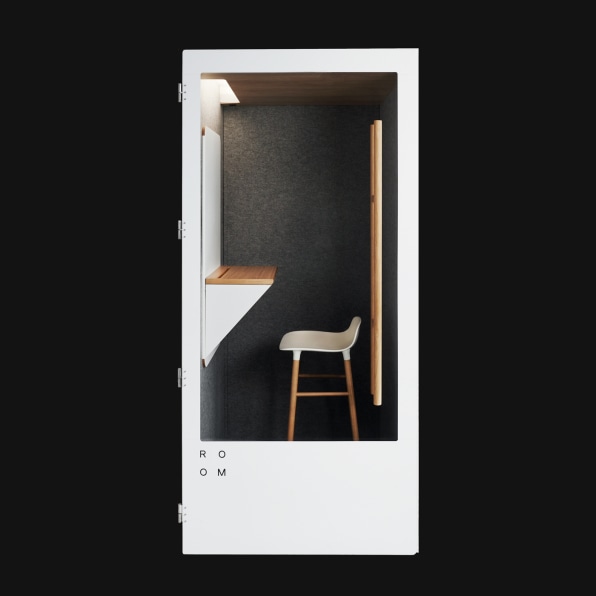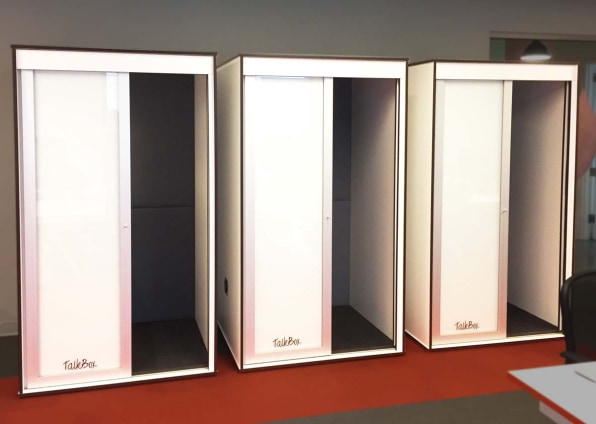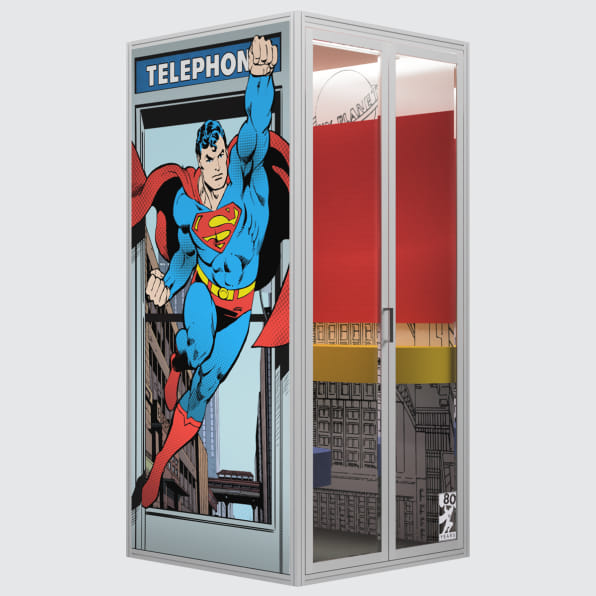In the past three years alone, half a dozen new companies have materialized out of thin air, all offering a new kind of office product. Call them pods. Boxes. Micro-offices. Phone booths. Cubicle nouveau. There’s no one name for them, but they all aim to fix the same problem: the misery of the modern open plan office.
These tiny, prefabricated rooms run from a few thousand dollars to over $10,000 apiece. Whereas cubicles of yore were open-air dividers, these new spaces are fully self-contained rooms. Most are the size of a phone booth, but some can squeeze in two or even four people. They have four walls and a roof, with soundproof paneling, active ventilation systems, and power for your laptop and USB devices. They’re private in every way–except for the fact that most feature a full-panel window on one wall. Setting them up can be as simple as rolling them to an open corner and plugging them in.
Unlike most cubicles, which house one employee each and every day, these are temporary spaces, meant for a few hours of work at a time, max. “While cubicles provide some sense of ‘territory’ or personal space, they still have shortcomings that phone booths can mitigate,” as Anthony Maraccini, CEO of the company Cubicall, puts it. In contrast, phone booths “provide a personal space that meets the four pillars of privacy: sound, visual, territorial, and informational.” Like many of his competitors that I spoke to, he insists that these pods are “not meant to replace one’s primary workspace. It’s an office feature to provide privacy and focus when needed.”
So why are these little rooms here, and why now? For one thing, because open offices are bad for the people who work inside of them–and companies themselves are guilty of squeezing too many people into too small of a space. Fixing these problems, or even just mitigating them, is a huge business opportunity for the companies that make these micro-offices–and their burgeoning industry offers a glimpse at the future of offices.
OPEN OFFICES ARE BROKEN
As many as 70% of offices in the U.S. are now of the “open plan” variety, where shared areas take priority over personal offices, according to an oft-cited stat from the International Facilities Management Association. In the 2000s, open offices certainly had a certain cachet, as a pointed rejection of ’90s cubicle culture. They were thought to increase collaboration. Prized by startups, these build-outs were also less expensive than traditional offices–and the seating arrangements allowed more people to be crammed into a smaller space.
As companies have migrated from suburban parks back to urban high-rises, real estate costs have grown while square footage has shrunk. Open offices are essentially sardine cans that offer a bohemian feel–like you’re in a casual relationship with your employer rather than a legal contract. They seemed so cool!
That was, until we learned about their psychological and social costs. In an open workspace, everyone is working on display all the time. In turn, making a simple phone call can feel like an intrusion to your coworkers, and women in particular feel as if they’re being constantly judged. Even productivity took a hit. And now employers want that productivity back–within the same open office footprint.
“We’ve heard a lot about open offices and how horrible they can be, which is true when you don’t offer choice,” says Kelly Griffin, principal and workplace strategy lead at the architecture and design firm NBBJ. “When you do offer choice . . . a place for people to go for privacy, that makes the experience much better.”
Much of Griffin’s job at NBBJ is talking to companies in the earliest planning stages of office rehabs and build-outs to try to match a space to their culture. In her experience, a lot of offices have been built out without really considering whether or not eavesdropping is a welcome part of the office culture or not. Micro-offices, on the other hand, “are a nice retrofit option when an office realizes we do need to accommodate a place for private phone calls.”
They’re also relatively cheap, and forgiving, in the grand scheme of running a company. “If a company has a short-term lease (less than five years), it’s not cost-effective to build conference rooms and privacy booths,” explains Ben Waskey, a product specialist and principal at Spaceworx. “With a modular product, it can be disassembled and moved to their next location.”
But isn’t there something inherently inhumane about sitting for hours inside a three-foot-by-three-foot box? “We had one in our office for a couple months,” says Griffin. “At first we were reluctant–I felt a little on stage, a little exposed. But we kind of fell in love with it after a while because it gave you a nice sense of a cocoon. Sometimes, you want to get into your little cubby or cave, and you want to feel protected.”
Write here…






